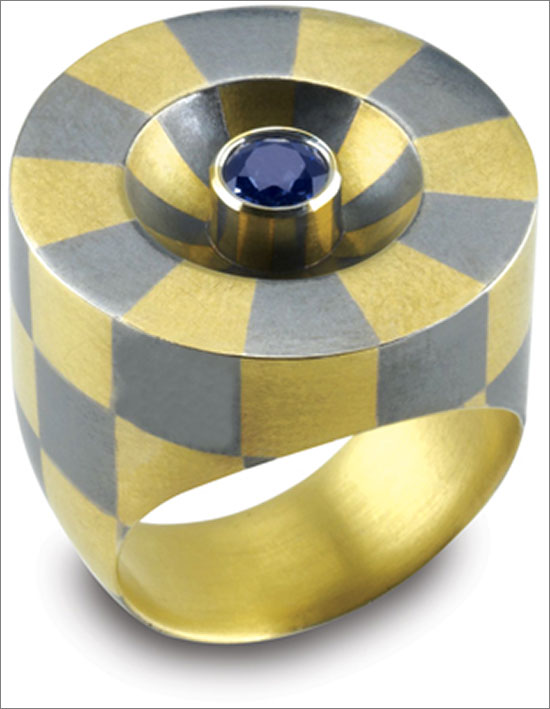Circus, Circus Ring By Pierre-Yves Paquette
Children and adults alike enjoy the spectacle of the circus. For jewelry designer Pierre-Yves Paquette of Pierre-Yves in Saint-Sauveur, Quebec, Canada, the circus inspired an award-winning jewelry design. Fascinated by the colors under the big top, Paquette created the Circus, Circus ring, winner of the gold jewelry category in the 2012 NICHE Awards. Pairing perfect squares of 18k yellow gold and sterling silver in a harlequin pattern reminiscent of a clown's costume, Paquette's ring required no-nonsense attention to detail.
3 Minute Read
Children and adults alike enjoy the spectacle of the circus. For jewelry designer Pierre-Yves Paquette of Pierre-Yves in Saint-Sauveur, Quebec, Canada, the circus inspired an award-winning jewelry design. Fascinated by the colors under the big top, Paquette created the Circus, Circus ring, winner of the gold jewelry category in the 2012 NICHE Awards.
Pairing perfect squares of 18k yellow gold and sterling silver in a harlequin pattern reminiscent of a clown's costume, Paquette's ring required no-nonsense attention to detail.
Circus, Circus By Pierre-Yves Paquette.
Winner
JewelryGold
2012 NICHE Awards
Alternating squares of 0.4-mm-thick silver and 18k gold soldered to a hollow silver base structure work their way up the ring. The squares on top of the ring narrow as they lead into the bowl, then change again as they slide into the rectangles that travel up the setting to the 1 carat blue sapphire.
After sketching the design, Paquette constructed a prototype in silver and brass, figuring out the correct metal thicknesses to make the piece work. It was like walking a tightrope: The squares had to be thin enough to be pushed easily onto the metal frame and shaped, but hard enough to wear well and hold the stone in place when the ring was complete.
Comprising a flat outer ring, a bowl-shaped inner circle, and a bezel, the ring top was made in three separate pieces. The entire bottom section, with the exception of a solid 18k yellow gold shank insert, was fabricated as one flat 0.6-mm-thick H-shaped piece of sterling silver. The squares were then positioned and stabilized prior to being soldered to the silver base pieces. When constructing the prototype, Paquette found that the bubbling of the flux was causing the squares to move around, so he needed to find a way to stabilize them. His solution was to use a graver to gather the silver base metal sheet beneath and pull small "tabs" up and over the edges of the squares. After soldering, he filed away the metal tabs.
After forming the top components, which included dapping the inner circle to a bowl shape, Paquette shaped the body of the ring slowly, annealing a few times as he worked the metal on a ring mandrel to make it round. "You have to be very gentle," he says. "It's all a matter of having the right tools."
In addition, Paquette left a hole in the center of the inner circle, which would eventually be hidden beneath the sapphire, to prevent the piece from exploding during final assembly should any water trapped inside from earlier work steam up.
Prior to final assembly, Paquette bevel-cut the separate components so they would match perfectly with no visible solder seams, then used medium solder to connect them. He slid a 0.4 mm thick 18k gold sleeve inside the ring and gently hammered it to fit the contour prior to soldering it in place with medium solder. "Once it's all put together the ring is about 1 mm thick, so it's a really sturdy piece," he says.
To achieve the desired matte finish, Paquette relied not on expensive finishing tools, but rather on a green Scotch Brite dish-scrubbing pad. After rubbing one all over the piece, he oxidized the ring in liver of sulfur before setting the sapphire. "The hole is under the stone, so I had to oxidize before setting the stone so I could make sure I could clean the ring well," he says.
Although this was a very time-consuming piece to create, clocking in at 30 hours, Paquette views it as a labor of love. "I enjoy working with a lot of different shapes of metal, playing with different colors, and trying different ideas," he says. In this ring, the colors of the circus translated to metal in award-winning ways, awing and entertaining onlookers much like their source of inspiration.
The award-winning Journal is published monthly by MJSA, the trade association for professional jewelry makers, designers, and related suppliers. It offers design ideas, fabrication and production techniques, bench tips, business and marketing insights, and trend and technology updates—the information crucial for business success. “More than other publications, MJSA Journal is oriented toward people like me: those trying to earn a living by designing and making jewelry,” says Jim Binnion of James Binnion Metal Arts.
Click here to read our latest articles
Click here to get a FREE four-month trial subscription.
You assume all responsibility and risk for the use of the safety resources available on or through this web page. The International Gem Society LLC does not assume any liability for the materials, information and opinions provided on, or available through, this web page. No advice or information provided by this website shall create any warranty. Reliance on such advice, information or the content of this web page is solely at your own risk, including without limitation any safety guidelines, resources or precautions, or any other information related to safety that may be available on or through this web page. The International Gem Society LLC disclaims any liability for injury, death or damages resulting from the use thereof.
The All-In-One Jewelry Making Solution At Your Fingertips
When you join the Ganoksin community, you get the tools you need to take your work to the next level.
Trusted Jewelry Making Information & Techniques
Sign up to receive the latest articles, techniques, and inspirations with our free newsletter.
